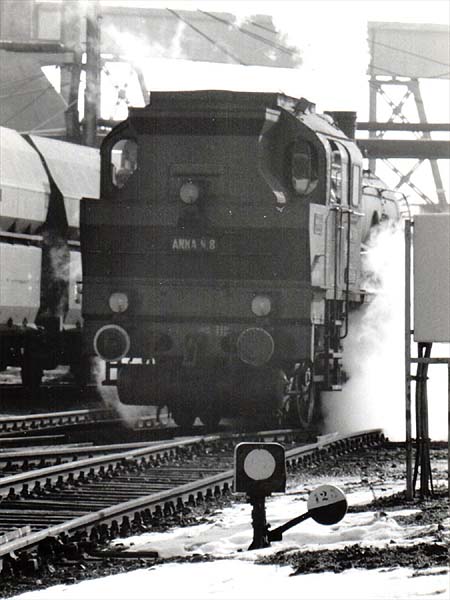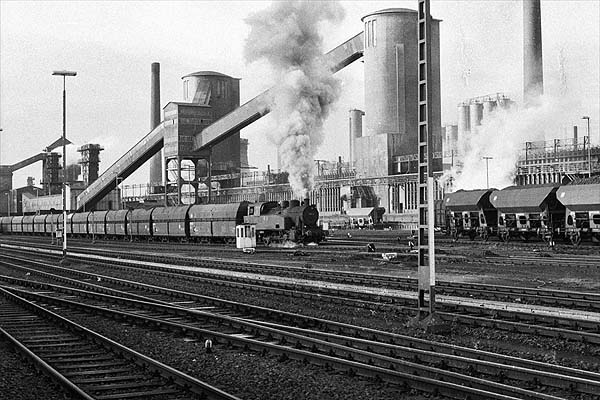|
Across the Low Countries to Westphalia for (a Little) Steam |
|
|
Keith Chambers writes:
Keith has now sent some extra pictures to go with the tale which I have appended at the end of the existing ones.(20th July 2016). In the tale ‘Former Belgian Heating Locos’ I refer to some West German industrial steam locomotives that I was travelling through Belgium to see. The trips I made to see those locomotives hardly warrant a tale but this short account serves as a focus for links to sites which record in far more detail than I can the surprisingly late steam operations that could be reached on a day trip by rail from London until 1992. The area was a coalfield just north of Aachen and just across the border into Germany. Many enthusiasts recorded the workings here and because of their late survival these records in the form of photographs and videos abound on the internet. The information I had at the time about the locomotives was from the Industrial Railway Society’s Pocketbook series on German Industrial Steam and was fifteen years out of date. I had no information on how to get permission to enter any collieries and knew that my visits would be hit and miss. That publication which cost a couple of pounds in the 1980s was recently advertised second hand on a well-known online bookseller for just under £40. I was staying with a Dutch friend in Utrecht. During my stay in the city I saw my first Dutch steam locomotives at the old railway museum and the very familiar British form of WD Austerity 2-10-0 73755 which had been Dutch State Railways 5085. (The NS had by far the largest number of these locomotives having purchased 103 of them post war compared with the twenty five that were inherited by British Railways.) The railway ran alongside the colliery here and on the opposite side of the line was a clear view of the sidings where much of the shunting took place. It was not long before we heard a working steam loco and sure enough 0-8-0T No. 3 shunted back and forth with long trains of coal wagons for the next couple of hours giving me great views and making plenty of noise. Not being able to enter the colliery complex I was unable to see the locomotive sheds which would have contained several more steam locos. There was another steam locomotive dead however. A small 0-4-0F stood in a nearby yard. So that was it and as there was a limit to what I could expect my partially-sighted friend who had no great interest in steam to tolerate, we left to sample the delights of Aachen’s hostelries. My second and last visit to the area was on 21st February 1991. I knew that steam would not last much longer so made the day trip alluded to in a previous tale. This was when it was possible to get a day return in winter from Dover to Ostende for £1. I drove down to Dover at night and parked my old 2CV on a side street and made my way on foot to the Eastern Docks crossing on the first ferry of the day (1 a.m.) and by the early hours of the morning was on my way by train to Aachen. As when travelling through the Netherlands I did not expect to see anything of steam interest. So my detour to the old steam shed at Leuven in Belgium was unexpected. I had noticed a steam loco dumped alongside as my train passed so jumped off at the station. When I investigated I found the two former heating locomotives mentioned in the Belgian tale. I was soon back on an SNCB train to Germany and a couple of hours later was on the bus to Alsdorf from Aachen Hbf. I had worked out my timings carefully. There were two collieries that I was aware of still with working steam, Alsdorf and nearby Siersdorf, so with the aid of a very helpful person at Aachen I was able to plan the buses to get me to both places and back to Aachen in time to get the train to Ostend and ferry to Dover within the day. I alighted from the bus in Alsdorf close to the level crossing which I knew was close to the exchange sidings where a few years before I had seen no. 3 shunting. I waited but little seemed to be happening. I climbed up a nearby slag heap hoping to gain a view over the complex which I succeeded in doing but I became no wiser as to the location of any working steam locomotive. It was an enjoyable walk though on this sunny day, with flocks of winter birds feeding on the plants colonising this man made hill. The next course of action was to walk around the perimeter of the huge site and hope to find a locomotive somewhere. At one point there were some large entrance gates and tracks across a public road and there beyond the gates was a live steam locomotive. And what a special locomotive it was. I cannot recall whether I knew a loco of this type was at Alsdorf until I saw it but in front of me was an ELNA locomotive, one of a series of standard locomotives built for industrial service. This was ‘Anna 8’ an 0-8-0WT. Some of the same type were main line locos in France as 040TX class and survived towards the end of SNCF steam. After watching it not do very much for some time I made my way to the bus to Siersdorf. I didn’t have much time left. The colliery complex here seemed to be surrounded by high fencing and with time running out I worked my way around some of the perimeter. There was an area of woodland outside this fencing covering quite a large area. At one point I heard the distinctive sounds of a steam locomotive and made my way hurriedly through these woods towards the fence. It was just possible to view the loco shunting sidings in the colliery. It carried a large number 3 on its smokebox door. I worked my way along the fence to the closest position I could get to where it was working. I had a new toy at the time which had already come in handy at Alsdorf earlier in the day – a telephoto lens. I certainly needed it now and managed to take a few shots from a distance as no. 3 went about its business at the end of its working life. I guessed that it must be time to head back to the bus and coming out of the woods and crossing a newly ploughed field I saw it coming along the road. I dashed the last hundred metres waving my arms and the bus and I arrived at the isolated bus stop together. Moments later I had begun my journey back to London. The links below are just a selection of many. Just putting combinations of dampf, dampflok, Alsdorf, Siersdorf, EBV or steam into a search engine will find more. Alternatively try the Drehsheibe German language website http://www.drehscheibe-online.de/startindex2.php click on Gemeinschaft go to the Historische Bahn forum and search (suche). Make sure that you set your search for 'jeden alters'.
Here are some pictures from the visits: 0-8-0T #3 at Alsdorf on 2nd January 1986:
The small fireless locomotive at Alsdorf on 2nd January 1986:
0-8-0WT ‘Anna 8’ at Alsdorf on 21st February 1991
Siersdorfon #3 on 21st February 1991
Two more pictures of #3 at Alsdorf:
The WD in the Utrecht Railway Museum (before it had its makeover):
The dumped heating locomotives at Leuven::
The 'impossible' ticket:
|











